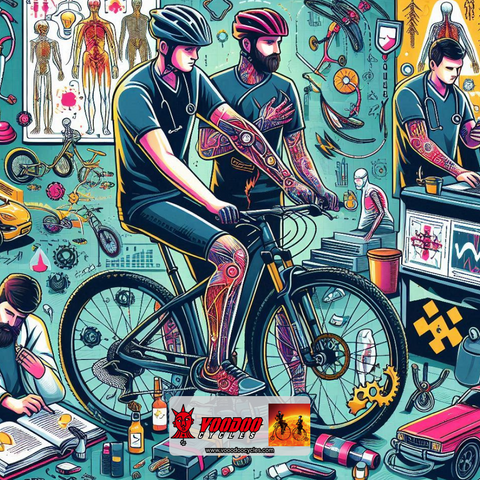
Mountain biking is a fun and adventurous sport that people from all over the world enjoy. Just like any other sport, it sometimes can be dangerous with injuries taking place. However, these injuries are mostly preventable if you prepare correctly, have the proper equipment, do the right pre-ride checks, and adopt proper riding techniques. In this blog, we'll explore how to prevent most common mountain biking injuries so you can ride safely with confidence.
Understanding Most Common Mountain Biking Injuries

What Are Most Common Mountain Biking Injuries?
Mountain biking injuries can range from small scrapes and bruises to more serious issues like fractures and concussions. Understanding these injuries is the first step in preventing them. Common mountain biking injuries include:
- Scrapes and Bruises: Often caused by falls or collisions with obstacles. Minor compared with other injuries, clean and sanitize if possible.
- Sprains and Strains: Often affect the knees, wrists, and ankles due to the rough terrain. Proper warm-up, hydration, and falling technique is a crucial preventive measure.
- Shoulder Injuries: Such as dislocations or rotator cuff tears from falling on an outstretched hand. If suspected, please seek professional help as soon as possible for assessment. Strength training, proper bike fit, and technique improvements are great preventative measures.
- Fractures: Typically result from more severe falls or crashes. Early signs may include swelling, deformity, inability to move, and grating sensation. If a fracture is suspected, move away from the trail, stabilize the injury, and call for help.
- Concussions: Can occur if a rider hits their head during a fall. Some initial symptoms include headaches, confusion, loss of memory, nausea, or slurred speech. If a concussion is suspected, please seek medical attention from a professional immediately.
Proper Equipment

Essential Gear to Prevent Injuries
Wearing the right protective gear is crucial in preventing injuries while mountain biking. Here’s a list of essential gear:
- Helmet: A high-quality helmet is non-negotiable. It protects your head from severe injuries and concussions.
- Knee and Elbow Pads: These pads protect against scrapes, bruises, and fractures.
- Gloves: Gloves provide grip and protect your hands from blisters and injuries during falls.
- Protective Clothing: Wear breathable, moisture-wicking clothing to stay comfortable and protect your skin.
- Proper Footwear: Sturdy shoes with good grip are essential for controlling the bike and protecting your feet.
Choosing the Right Bike
Selecting the right mountain bike can make a significant difference in your safety and performance. Consider the following:
- Type of Bike: Choose a bike that matches your riding style and terrain. Voodoo mountain bikes, for example, are known for their durability and performance on various terrains.
- Bike Fit: Ensure your bike is the right size for your height and body type. A poorly fitted bike can lead to discomfort and increase the risk of shoulder injuries.
- Regular Maintenance: Keep your bike in top condition by regularly checking and maintaining the brakes, tires, and gears. This not only enhances performance but also prevents mechanical failures that can lead to accidents.
Preparing for the Ride


Pre-Ride Checks and Maintenance
Performing pre-ride checks is a crucial step in preventing injuries. Here’s what to look for:
- Brakes: Ensure they are responsive, brake pads in good condition, and functioning correctly.
- Tires: Check for proper inflation and look for any symbols of wear or damages.
- Gears: Make sure they shift smoothly.
- Chain: Ensure it's clean and lubricated to prevent it from snapping or slipping.
- Suspension: Check for proper functioning, especially if planning to ride on rough terrain.
Warm-Up and Stretching Exercises
Warming up before a ride can significantly reduce the risk of injuries such as sprains and strains. Here are some effective warm-up and stretching exercises:
- Dynamic Stretches: Include leg swings, arm circles, and torso twists to increase blood flow and flexibility.
- Specific Stretches: Focus on the muscles you'll use most, such as hamstrings, quadriceps, and calves.
- Light Cardio: A few minutes of jogging or cycling at a slow pace can get your heart rate up and initiate your body for the ride.
On the Course
Riding Techniques
Using proper riding techniques is essential to prevent injuries. Here are some tips:
- Maintain Proper Posture: Keep your back straight, elbows slightly bent, and knees flexed. This posture helps absorb shocks and maintains balance.
- Handle Rough Terrain: When riding over rough terrain, keep your center of gravity low, centered, and use your legs as shock absorbers. Stand on the pedals to have increased control and stability.
- Controlled Speed: Always ride at a speed you're comfortable with, especially on unfamiliar trails. Slowing down gives you enough time to react to hazards.
Staying Aware of Your Surroundings
Being aware of your surroundings can prevent many injuries. Here’s how:
- Stay Alert: Constantly scan the trail ahead for obstacles like rocks, roots, and sudden drops.
- Anticipate Obstacles: Plan your path to avoid or navigate around obstacles smoothly.
- Adjust Speed: Slow down when approaching tricky sections of the trail. This gives you more control and reduces the risk of falling.
- Ride with a Buddy: If possible, ride with a friend. They can alert you to upcoming hazards and provide assistance in case of a seriours injury.
After the Ride

Cool Down and Stretching
Cooling down after a ride is equally important as warming up. It helps your muscles recover and reduces soreness. Here’s what to do:
- Light Cycling: Slow down your pace for the last few minutes of your ride to gradually decrease your heart rate.
- Stretch, stretch, stretch: Focus on stretching the muscles you've used the most. Maintain each stretch for at least 30 seconds. Include stretches for your hamstrings, quadriceps, calves, and back.
- Hydrate: Drink plenty of water to rehydrate your body which will also help with muscle recovery.
First Aid and Injury Management
Knowing basic first aid can be very helpful if you or a riding companion get injured. Here are some tips:
- Basic First Aid Kit: Carry a small kit with bandages, antiseptic wipes, and pain relievers.
- Treating Minor Injuries: Clean and dress scrapes and cuts to prevent infection.
- Handling Serious Injuries: If you suspect a fracture or concussion, seek professional medical help immediately. Avoid moving the injured person if there's a risk of spinal injury.
Conclusion
Most common mountain biking injuries can be prevented if proper measures are in place; a combination of preparation, using the right equipment, proper training, and safe riding practices. By following these tips, you can enjoy the thrill of mountain biking while minimizing the risk of injuries. Remember, safety always comes first, so gear up, stay alert, and ride responsibly. Let’s ride to mars together.
FAQs
What should I do if I get injured while mountain biking?
If you get injured, first assess the severity of the injury. For minor injuries like scrapes and bruises, clean and dress the wound. For more serious injuries, such as fractures or head injuries, seek professional medical help immediately. It's also helpful to carry a basic first aid kit and know how to use it.
How can I choose the right protective gear for mountain biking?
Choosing the right protective gear is crucial for safety. Start with a high-quality helmet that fits well. Knee and elbow pads, gloves, and proper footwear are also essential. Make sure your gear is comfortable and doesn't restrict movement. Investing in quality gear can make a significant difference in preventing injuries.
Are Voodoo mountain bikes suitable for beginners?
Yes, Voodoo mountain bikes are suitable for beginners. They offer a range of bikes designed for different skill levels and terrains. Voodoo bikes are known for their durability, performance, and comfort, making them a great choice for riders of all levels, including beginners.
What are the best stretches to do before and after mountain biking?
Before mountain biking, dynamic stretches like leg swings, arm circles, and torso twists are effective. After your ride, focus on static stretches for the muscles used the most, such as hamstrings, quadriceps, calves, and back. Maintain each stretch for at least 30 seconds to ensure proper muscle recovery.
How often should I replace the protective gear for mountain biking?
The lifespan of protective gear depends on usage and wear. Helmets should be replaced every 3-5 years or after any critical impact. Pads and gloves should be inspected regularly for signs of wear and replaced if they become damaged or lose their protective qualities. Regular checks and timely replacements ensure optimal safety.







